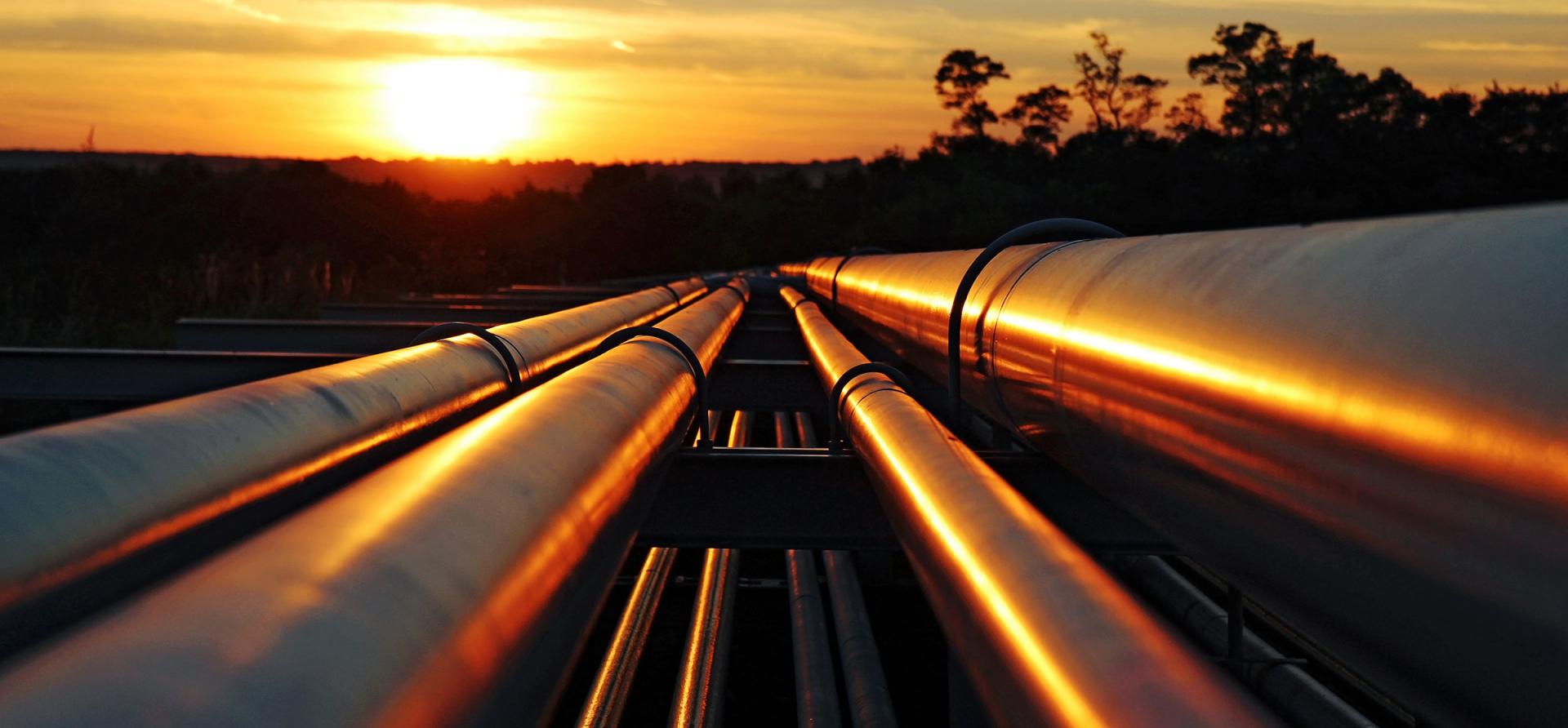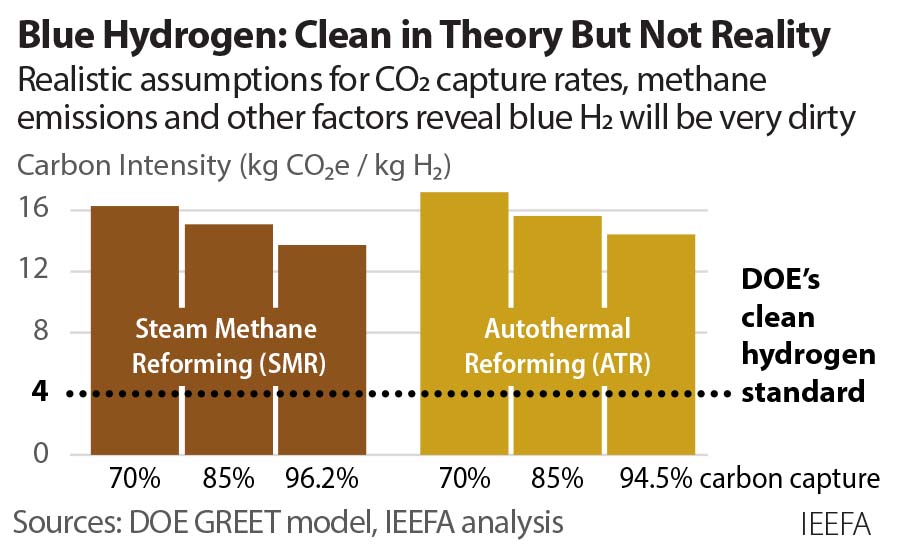
Key Findings
The U.S. government significantly understates the likely impact of producing hydrogen from fossil fuels on global warming in at least four ways.
It assumes that just 1% of the methane being used to produce hydrogen will be emitted into the atmosphere between the well and the production facility. This is far less than recent peer-reviewed scientific analyses have found and that has been identified by airplane and satellite emission surveys.
It focuses solely on the 100-year Global Warming Potential (GWP) of methane, a very potent greenhouse gas. This significantly understates methane’s environmental impact on global warming, since its 20-year GWP is more than 80 times that of carbon dioxide while its 100-year GWP is much lower.
Contrary to scientific evidence, it assumes that hydrogen does not have any impact on global warming when it leaks into the atmosphere.
It relies on the overly optimistic and unproven assumption that hydrogen production projects will be able to capture almost all of the carbon dioxide they create.
Executive Summary
Blue hydrogen hype has spread across the U.S., spurred by the billions of dollars of government funding and incentives included in the 2021 Bipartisan Infrastructure Law (BIL) and the 2022 Inflation Reduction Act (IRA). The fossil fuel industry promises that blue hydrogen, produced from methane or coal, can be manufactured cleanly and contribute to climate change mitigation measures. As we demonstrate in this report, the reality is that blue hydrogen is neither clean nor low-carbon. In addition, pursuing it will waste substantial time that is in short supply and money that could be more wisely spent on other, more effective investments for reducing greenhouse gas emissions in the immediate future.
In short, fossil fuel-based “blue” hydrogen is a bad idea.
Blue hydrogen’s environmental benefits rest largely on the assumptions baked into a Department of Energy (DOE) model named GREET (Greenhouse Gases, Regulated Emissions and Energy use in Transportation) that is the congressionally mandated evaluation tool for U.S. hydrogen projects. Due to a set of unrealistic and flawed assumptions, the model significantly understates the likely greenhouse gas intensity associated with blue hydrogen production.1
Among the key shortcomings:
- It assumes an upstream methane emission rate of just 1%. This is far less than recent peer-reviewed scientific analyses have found and what has been demonstrated by numerous airplane and satellite surveys.
- It uses a 100-year Global Warming Potential (GWP). This significantly understates methane’s environmental impact in the short term, since its 20-year GWP is more than 80 times that of carbon dioxide (CO2).
- It does not include any estimate (either over 20 or 100 years) for the global warming impact of hydrogen, which works to extend the lifetime of methane and increase its atmospheric abundance. Hydrogen also has a 20-year GWP more than 30 times that of CO2.
- It does not include a full life cycle analysis (LCA) of all the emissions from the blue hydrogen production process. In particular, downstream emissions from the produced hydrogen and the generation of the electricity needed to compress, store and transport the hydrogen to the ultimate user(s) are excluded.
- It includes overly optimistic assumptions about the effectiveness of carbon capture processes.
Using more realistic numbers shows blue hydrogen to be a dirty alternative. For example, if we change just two variables—using methane’s 20-year GWP and a more realistic 2.5% methane emission rate—the carbon intensity of blue hydrogen calculated by GREET jumps to between 10.5 and 11.4 kilograms of CO2e/kgH2 (kilograms of carbon dioxide equivalents emitted per kilogram of hydrogen). This is between two and three times the 4.0 kg CO2e/kg hydrogen Clean Hydrogen Production Standard (CHPS) established by Congress and the DOE. Note that these already very high carbon intensity figures still reflect DOE’s overly optimistic assumption that hydrogen production facilities will capture at least 94.5% of the CO2 they produce. They also exclude the impact of downstream hydrogen emissions.
If more conservative assumptions are used, reflecting: 1) more realistic carbon capture rates; 2) downstream leakage of the hydrogen produced; and 3) downstream CO2e emissions from the production of the electricity needed to fully compress, store and transport the hydrogen to the site where it will be used, then blue hydrogen gets even dirtier, with a carbon intensity more than three times as much as the DOE’s clean hydrogen standard.
Figure ES 1: The Carbon Intensity of Blue Hydrogen Using 20-Year GWPs and More Reasonable Ranges of Assumptions for Methane Emissions and Hydrogen Leakage, Related Downstream Emissions and Carbon Capture Rates

Source: DOE GREET model, IEEFA analysis.
Given these results, IEEFA is extremely concerned that the current blue hydrogen hype is going to result in the funding of projects that exacerbate climate change and lock in our reliance on fossil fuels for decades. For this reason, we have undertaken a series of analyses into the emissions from blue hydrogen production based on current scientific knowledge of methane emissions and hydrogen leakage rates and the existing status of carbon capture and sequestration (CCS) technologies. This report focuses on the production of blue hydrogen from methane; a subsequent report will examine hydrogen from coal gasification.
1 A 2021 paper by Robert Howarth and Mark Jacobson examined whether the life cycle emissions associated with making hydrogen from methane were low-carbon. See: How Green is Blue Hydrogen? August 12, 2021. IEEFA's new analysis confirms Howarth and Jacobson’s core finding that producing blue hydrogen from methane is neither clean nor low-carbon, even when using the DOE’s GREET model, which Congress has mandated use of in making determinations under the Inflation Reduction Act. DOE cannot justify hiding behind the GREET model in perpetuating misinformation about blue hydrogen's impact on greenhouse gas emissions.
Watch IEEFA's recent webinar on blue hydrogen above, featuring report co-authors David Schlissel and Anika Juhn.















